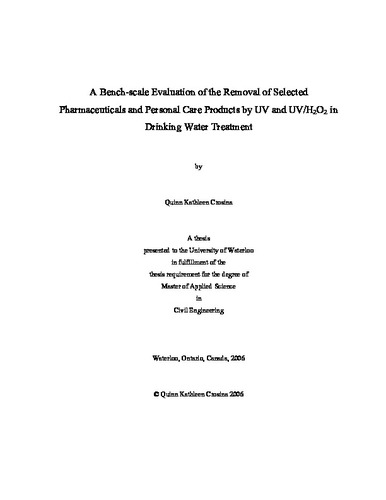| dc.description.abstract | A bench-scale study of the degradation of four selected pharmaceuticals and personal care products (PPCPs) was carried out using UV and UV/H₂O₂ treatment employing low pressure (LP) and medium pressure (MP) lamps. The target substances included the pharmaceutical compounds ibuprofen, naproxen, and gemfibrozil, along with the bactericide triclosan. There were four main objectives of the study, as follows: to evaluate the removal of the target compounds using UV irradiation alone and UV/H₂O₂, to determine the reaction kinetics for direct and indirect photolysis of each selected compound, to determine the influence of major water quality parameters on the efficacy of treatment, and to compare the applied UV and UV/H₂O₂ doses to those that have been found to be effective for disinfection and removal of taste and odour compounds, respectively.
For initial ultra-pure water experiments the target compounds were spiked at concentrations of approximately 250 µg/L (~1 µM). In latter ultra-pure water experiments and in the partially-treated water experiments, the selected PPCPs were spiked at a lower range (c~500-1000 ng/L), which is more representative of reported environmental concentrations. In an ultra-pure water matrix, a high LP fluence of 1000 mJ/cm² caused only triclosan to substantially degrade. Furthermore, with LP-UV/H₂O₂ only triclosan and naproxen had average percent removals above 60% at a typical disinfection fluence of 40 mJ/cm² with 100 mg/L H₂O₂. Complete degradation of all four compounds in ultra-pure water was achieved with very high fluences (compared to those used for UV disinfection) with MP-UV alone (at or above 1000 mJ/cm²) or with relatively high fluences for MP-UV/H₂O₂ (200-300 mJ/cm²) with 10 mg/L H₂O₂. Overall, when compared at similar applied fluences, the MP lamp was much more effective than the LP lamp. Furthermore, the addition of H₂O₂ typically increased removal rates, in some cases substantially, through formation and subsequent reaction of the PPCP with the •OH radical.
When target substances were treated all together in an ultra-pure water solution, removals were lower than when they were treated independently at the same individual concentrations (~250 µg/L) this may simply have been the result of a higher total contaminant concentration in solution, which lessened the availability of the •OH radical and incident UV irradiation for degradation of all compounds. On the other hand, removals were improved when the combined target compounds were present at a lower individual concentration range (~750 ng/L), which suggests that removals may be concentration driven, with reduced matrix effects seen at lower overall contaminant concentrations. Furthermore, during the partially-treated water experiments, variability in treatment performance was observed with differing water quality; however, it was not evident which specific quality parameters influenced treatment effectiveness. On the other hand, substantial and sometimes complete, degradation of the target compounds was still seen in the partially-treated water with high MP-UV/H₂O₂ doses (e.g. 300 mJ/cm² + 10 mg/L H₂O₂ and 500 + 10 mg/L H₂O₂).
For the kinetic experiments, compounds were spiked individually in ultra-pure water (c~250 µg/L = ~1µM). The photolysis of the target compounds during treatment was assumed to be a pseudo-first-order reaction. Kinetic parameters were determined for both direct and indirect photolysis for both lamps. The calculated rate constants confirmed the importance of •OH radicals for degradation of these compounds, especially for ibuprofen and gemfibrozil. For ibuprofen and gemfibrozil, direct photolysis rate constants could not be determined for LP-UV because very little degradation was seen at the fluences tested. LP-UV direct phototlysis rate constants for naproxen and triclosan were 0.0002 and 0.0033 cm²/mJ, respectively. Overall rate constants describing degradation of the four compounds due to LP-UV/H₂O₂ ranged from 0.0049 to 0.0124 cm²/mJ. All four compounds had fluence-based reaction rate constants for MP-UV indirect photolysis of approximately 0.01 cm²/mJ, while MP-UV direct photolysis rate constants ranged between 0.0007-0.007 cm²/mJ, with ibuprofen having the lowest and triclosan the highest.
The overall trends were similar to those seen by other researchers for the removal of taste and odour compounds. For example, fluences required for substantial removal were much higher than typical disinfection doses, the MP lamp was more effective than the LP lamp (when compared solely on a fluence-basis), and the addition of H₂O₂ improved removals.
On the whole, UV/H₂O₂ appears to be a very promising technology for the removal of these selected PPCPs during drinking water treatment, and is likely to be equally effective for other, similar contaminants. | en |

